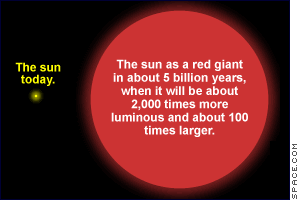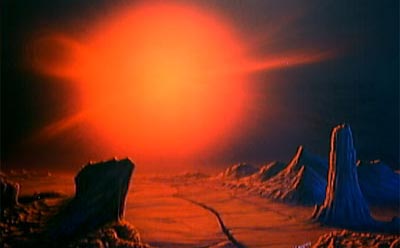Science Fiction
Dictionary
A B C D E F G H I J K L M N O P Q R S T U V W X Y Z
Dying Stars And Planets To Live On

Astronomers have long thought that the best place for life as we know it is a planet in the "habitable zone" - the range of orbits that leads to planets with liquid water - surrounding a main sequence star like our sun. Science fiction writers know better - and now astronomers are rethinking past work.

(Our sun as a red giant)
American astrophysicist William Danchi, and French colleagues Bruno Lopez and Jean Scheider, argue that the search for planets should not be limited to main sequence stars like our sun. The main sequence is only the first stable period of our sun's life; when it begins to burn its hydrogen around a growing helium core it offers another period of several billion years of stability. Finally, stars that have the right mass eventually become red giants; the temperature of the star's core increases as it shrinks, but the outer layers expand and cool. The "habitable zone" of a red giant (like the sun will be) extends from about 630 million miles to 2 billion miles.
Danchi, Lopez and Schneider argue that about 150 sub-giant and red giant stars are situated within 100 light years of Earth (compared to about 1,000 main sequence stars). NASA's Terrestrial Planet Finder space mission will focus only on main sequence stars. These stars will have habitable planets that are further from their suns, and will therefore be easier to find in the glare of the parent stars.

(Roter Riese)
Science fiction authors have long used red giant stars as a convenient location for alien civilizations; often, it is used to denote the planet of a very ancient and wise civilization. In his 1953 novel Childhood's End, Arthur C. Clarke describes the planet of the Overlords who came to help Earth through a difficult developmental stage:
This was the supreme moment of his life: now he was to be the first human being ever to look upon a world lit by another sun...It was cold, though not uncomfortably so. The light from the great red sun low down on the horizon was quite ample for human eyes, but Jan wondered how long it would be before he yearned for greens and blues. Then he saw that enormous, wafer-thin crescent reaching up the sky like a great bow placed beside the sun. He stared at it for a long time before he realized that his journey was not yet altogether ended. That was the world of the Overlords. This must be its satellite, merely the base from which their vessels operated.
Read more at Dying stars could make frozen planets habitable. You might also like Planets May Wander Alone and Massive Planetoids From Beyond The Solar System. If you are concerned that the Earth will no longer lie in the "habitable zone" when our sun becomes a red giant, read what science fiction authors have had to say about moving a planet.
Scroll down for more stories in the same category. (Story submitted 3/29/2005)
Follow this kind of news @Technovelgy.| Email | RSS | Blog It | Stumble | del.icio.us | Digg | Reddit |
Would
you like to contribute a story tip?
It's easy:
Get the URL of the story, and the related sf author, and add
it here.
Comment/Join discussion ( 0 )
Related News Stories - (" Space Tech ")
Will Space Stations Have Large Interior Spaces Again?
'They filed clumsily into the battleroom, like children in a swimming pool for the first time, clinging to the handholds along the side.' - Orson Scott Card, 1985.
Reflect Orbital Offers 'Sunlight on Demand' And Light Pollution
'I don't have to tell you about the seven two-mile-diameter orbital mirrors...'
Chrysalis Generation Ship to Alpha Centauri
'This was their world, their planet —
this swift-traveling, yet seemingly moveless vessel.' - Nat Schachner, 1934
The First Space Warship For Space Force
'Each of the electrical ships carried about twenty men...' - Garrett P. Serviss, 1898.
Technovelgy (that's tech-novel-gee!) is devoted to the creative science inventions and ideas of sf authors. Look for the Invention Category that interests you, the Glossary, the Invention Timeline, or see what's New.
Science Fiction
Timeline
1600-1899
1900-1939
1940's 1950's
1960's 1970's
1980's 1990's
2000's 2010's
Current News
The Zapata Air Scooter Would Be Great In A Science Fiction Story
'Betty's slapdash style.'
Thermostabilized Wet Meat Product (NASA Prototype)
There are no orbiting Michelin stars. Yet.
Could Crystal Batteries Generate Power For Centuries?
'Power could be compressed thus into an inch-square cube of what looked like blue-white ice'
India Ponders Always-On Smartphone Location Tracking
'It is necessary... for your own protection.'
Amazon Will Send You Heinlein's Knockdown Cabin
'It's so light that you can set it up in five minutes by yourself...'
Is It Time To Forbid Human Driving?
'Heavy penalties... were to be applied to any one found driving manually-controlled machines.'
Replace The Smartphone With A Connected Edge Node For AI Inference
'Buy a Little Dingbat... electropen, wrist watch, pocketphone, pocket radio, billfold ... all in one.'
Artificial Skin For Robots Is Coming Right Along
'... an elastic, tinted material that had all the feel and appearance of human flesh and epidermis.'
Robot Guard Dog On Duty
I might also be thinking of K-9 from Doctor Who.
Wearable Artificial Fabric Muscles
'It is remarkable that the long leverages of their machines are in most cases actuated by a sort of sham musculature...'
BrainBridge Concept Transplant Of Human Head Proposed
'Briquet’s head seemed to think that to find and attach a new body to her head was as easy as to fit and sew a new dress.'
Google's Nano Banana Pro Presents Handwritten Math Solutions
'...copy was turned out in a charming and entirely feminine handwriting.'
Edible Meat-Like Fungus Like Barbara Hambly's Slunch?
'It was almost unheard of for slunch to spread that fast...'
Sunday Robotics 'Memo' Bot Has Unique Training Glove
'He then started hand movements of definite pattern...'
Woman Marries Computer, Vonnegut's Dream Comes True
'Men are made of protoplasm... Lasts forever.'
Natural Gait With Prosthetic Connected To Nervous System
'The leg was to function, in a way, as a servo-mechanism operated by Larry’s brain...'
